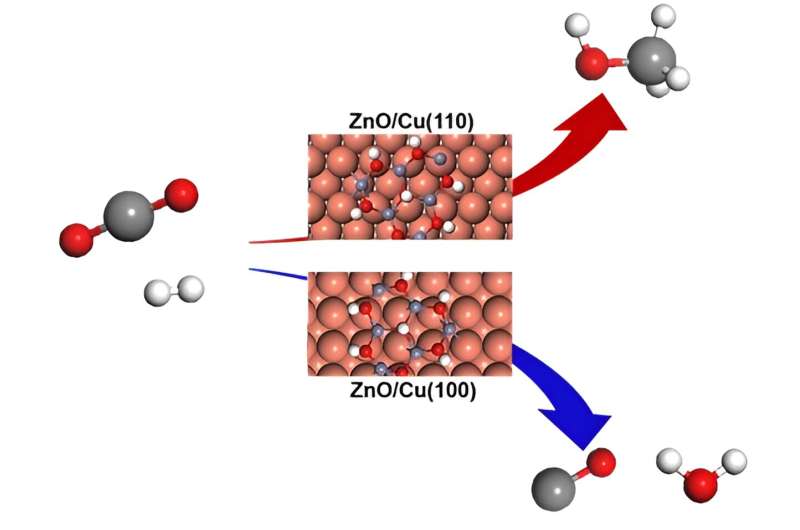This article has been reviewed according to Science X's editorial process and policies. Editors have highlighted the following attributes while ensuring the content's credibility:
fact-checked
trusted source
proofread
Active copper structures in ZnO-Cu interfacial catalysis: CO₂ hydrogenation to methanol

Recent research published in the journal Science China Chemistry explores active copper structures in ZnO-Cu interfacial catalysis. Many experiments, including catalyst preparation, structural characterizations, catalytic performance evaluation, and DFT calculations, were performed.
Using various Cu nanocrystals (NCs) with well-defined Cu facets and corresponding ZnO/Cu NCs inverse catalysts, the Cu{110} facet was demonstrated as the most active facet for ZnO-Cu interfacial catalysis in CO2 hydrogenation to methanol with apparent activation energy as low as 25.3±2.6 kJ/mol, while the Cu{100} facet as the most active facet for both ZnO-Cu interfacial catalysis and Cu catalysis in RWGS reaction.
Meanwhile, although the ZnO-Cu interface is more active in catalyzing RWGS reaction than the Cu surface, the RWGS reaction occurs mainly on the bare Cu surface of ZnO/Cu inverse catalysts instead of at the ZnO-Cu interface, under the CO2 hydrogenation to methanol reaction condition.
The study was led by Prof. Weixin Huang (Key Laboratory of Precision and Intelligent Chemistry, University of Science and Technology of China), Prof. Wenhua Zhang (Key Laboratory of Precision and Intelligent Chemistry, University of Science and Technology of China), and Dr. Zongfang Wu (Hefei National Research Center for Physical Sciences at the Microscale, University of Science and Technology of China).
"Uniform catalytic nanocrystals with well-defined structures have demonstrated great potential for fundamental studies of heterogeneous catalysis under working conditions. Cu-ZnO-based catalysts have been extensively studied for catalyzing CO2 hydrogenation to value-added methanol, in which the methanol selectivity, however, is limited by the accompanying RWGS reaction," Huang says.
"Using Cu single crystal-based model catalysts, catalytic performance of Cu and ZnO/Cu catalysts in both CO2 hydrogenation to methanol and RWGS reactions were demonstrated to be sensitively dependent on the Cu crystal planes, but the measured CO formation rates were two to three orders of magnitude higher than the corresponding CH3OH formation rates, in contrast to the catalytic performance of Cu-ZnO-based powder catalysts."
"In order to address the controversy between the powder catalysts and single crystal model catalysts, we have conducted a combined experimental and theoretical calculation study of Cu NCs with well-defined Cu facets and corresponding ZnO/Cu NCs inverse catalysts under typical conditions of CO2 hydrogenation to methanol and RWGS reactions."
The acquired results on the active Cu facet for ZnO-Cu interfacial catalysis for CO2 hydrogenation to methanol and RWGS reactions not only deepen the fundamental understanding of structure sensitivity of ZnO-Cu interfacial catalysis but also suggest the {110} facet engineering of Cu nanoparticles with minimized exposed bare Cu surfaces in Cu-ZnO based catalysts as a promising strategy to fabricate a highly active and selective catalyst for CO2 hydrogenation to methanol at low temperatures.
Kinetically, the methanol synthesis reaction at the ZnO-Cu{110} interface with a very low Ea of approximately 25.3 kJ/mol proceeds facilely at low temperatures while the RWGS reaction with a high barrier surface does not thermodynamically, a low reaction temperature favors the exothermic methanol synthesis reaction but not the endothermic RWGS reaction.
More information: Wei Xiong et al, Active copper structures in ZnO–Cu interfacial catalysis: CO2 hydrogenation to methanol and reverse water–gas shift reactions, Science China Chemistry (2023). DOI: 10.1007/s11426-023-1802-7
Provided by Science China Press





















